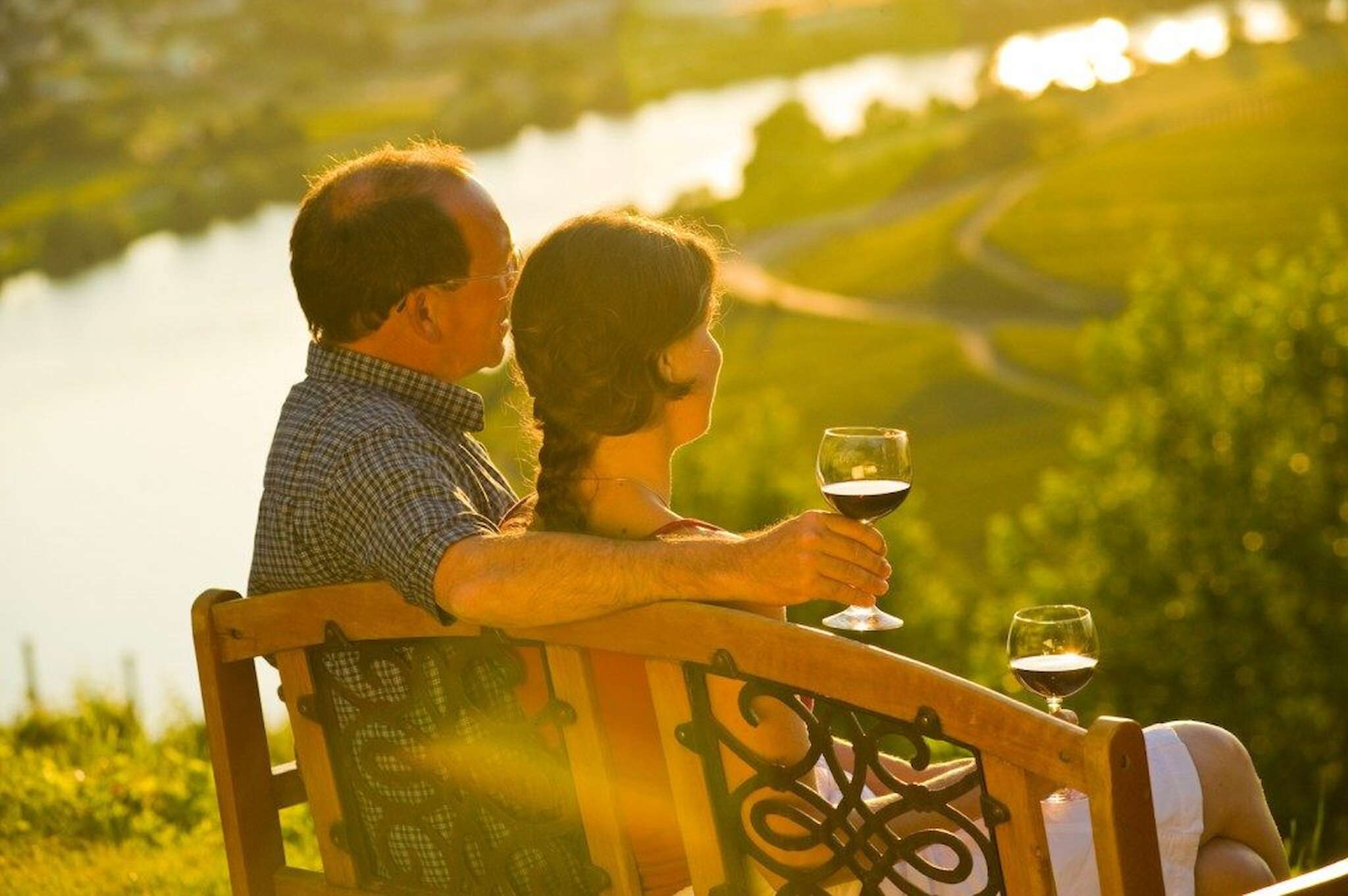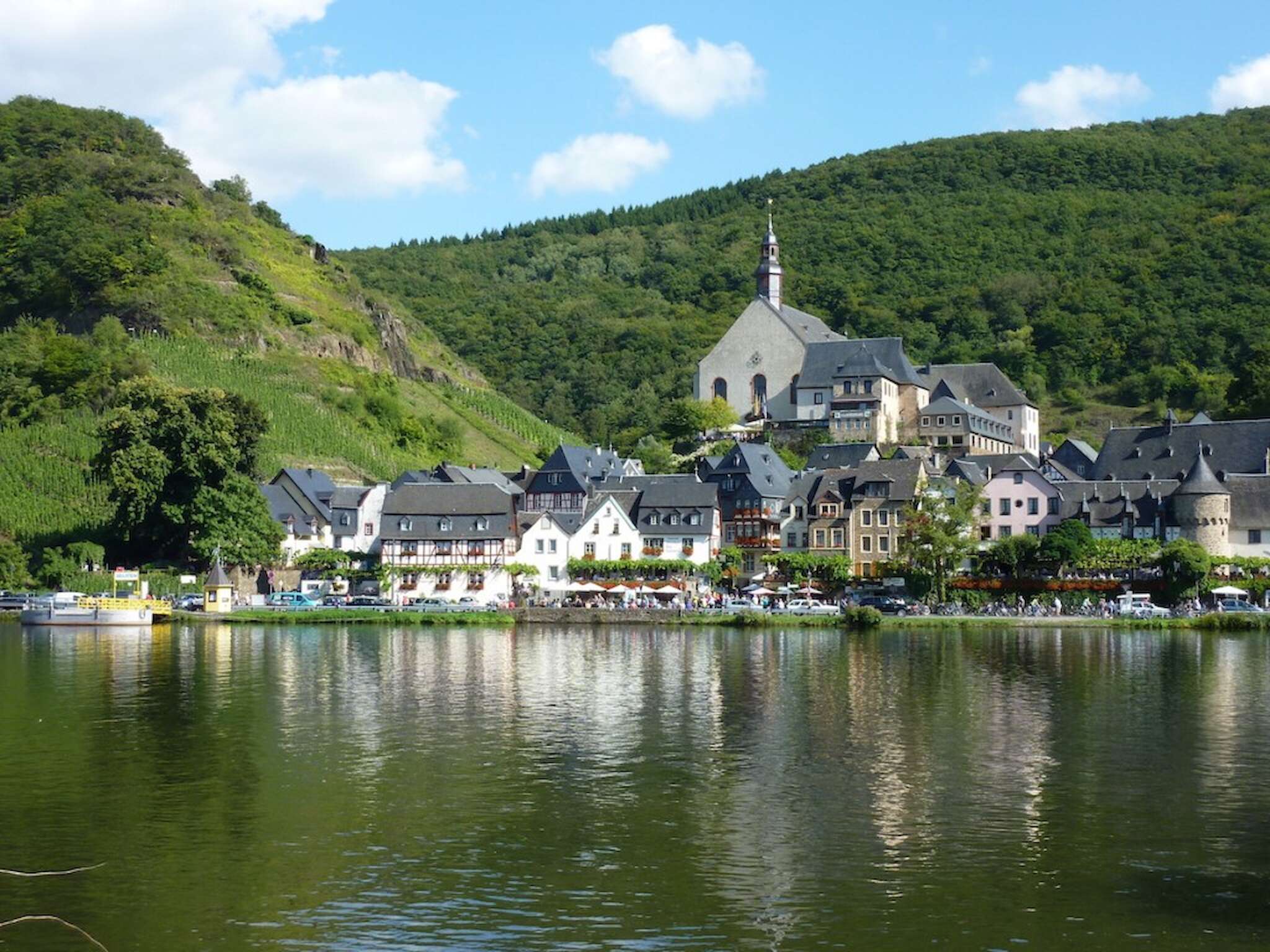


The following article about the Mosel Bike Path was written by BikeTours.com president Jim Johnson and published in 1998, shortly after his first bicycle tour in the region. See all tours along the Mosel here.
The question often comes up: “Rhine or Mosel?” Whether the inquiry is about wine or travel, the answer is the same: “It’s a matter of taste.”
For travelers, there are certainly differences. The Mosel is much narrower and curvier than the Rhine, meandering nearly 200 kilometers (125 miles) to cover the 100-kilometer (62-mile) distance between Trier and Koblenz. It’s slower and calmer than the Rhine. Its micro-climate is almost Mediterranean, with cold-weather days often 8-10 degrees warmer than in towns off the river. There’s almost a softer feel to it, as if viewing the landscape through thin gauze. It’s probably no coincidence that the German language uses the masculine “der” for the Rhine and the feminine “die” for the Mosel.
A quiet path with no pretense

Main roads have been diverted. Even the trains cut through hills rather than parallel the entire river, dropping the decibels a few notches. The towns and villages—Cochem aside—are commonly uncrowded, even more so with the closure of nearby French and American military bases.
Between Trier and Koblenz, there’s scarcely any industry to be found except for winemaking and, in the number two spot, tourism. That ranking is important for visitors, since it often means a more “authentic” experience than in more tourism-dependent areas.
Villages feel like villages, where everyone knows everyone. In the hamlet of Longuich, Mayor Josef Schmitt officiated at a street festival—and appeared a short time later at an outdoor café—wearing a green apron and taking lunch orders. There’s no pretense.
“We don’t think of ourselves as a tourist attraction,” said one vintner in Bremm, a charming village about mid-way between Trier and Koblenz. “We just do what we do, in some ways no differently today than 200 years ago. People don’t sightsee here; they visit.”
Most of “what they do” relates to winemaking, and vineyards indeed stretch as far as the eye can see—or at least until the next curve in the river. Many of the region’s guests come to visit specific vintners year after year—to re-stock their Rieslings and swap family stories. And many cozy guesthouses are run by vintners to augment their incomes (and hedge against bad years).
Charm galore
Which isn’t to say the region lacks a tourism infrastructure; there are charming inns and elegant hotels, and chefs take full advantage of local produce—and abundant wine. Across the board, travelers will find prices—whether for lodging or meals—generally lower than along the Rhine and more touristy areas.
Our friendly vintner notwithstanding, visitors have ample sights to see beyond the vineyards, including Roman ruins, stunning castles and half-timber towns.
In Longuich and across the river in Mehring, travelers can visit two Roman villas, rebuilt in part but with much of their ancient old foundations intact. In Neumagen-Dhron, there’s a replica of a giant stone carving of a Roman wine ship (the original, discovered in the village, is in the Municipal Museum in Trier).
At the other end of the architectural spectrum, Traben-Trarbach has the unique appeal of having a complete district with Jugendstil (art nouveau) as the primary architectural style. Much of the town burned to the ground in a series of fires during the late 19thcentury. After a design competition to rebuild the popular Hotel Bellevue, Jugendstil was all the rage.
Bernkastel-Kues is perhaps the postcard-perfect Mosel town, complete with castle ruins, half-timber houses, medieval marketplace and architectural styles spanning nearly two millennia. There’s another compelling reason to visit this delightful town: the Vinothek, where 9 EUR ($10) open the door to an unlimited sampling of 130 wines from the Mosel region. Sampler bottles stand in front of the 130 racks, with descriptive cards giving prices and backgrounds on the vintner. There are spit buckets and water pitchers for serious samplers. (Weinkulturelles Zentrum, Cusannusstrasse 2, D-54470 Bernkastel-Kues, tel: +49/6531/4141, fax: 4155, web: www.bernkastel-vinothek.de (in German), email: info@bernkastel-vinothek.de.)
Affiliated with the Vinotek is the adjacent Wine Museum, with old tools and equipment that show how the industry has changed over the centuries.
History and wine
One thing that hasn’t changed is how vines are tended and grapes are picked. It’s as manual today as ever. Travelers who want a first-hand experience should visit the Weingut Schauf, a popular winery in the village of Ediger-Eller.
Schauf’s vineyards are on the Bremmer Calmont, at 65 degrees (90 would be vertical) the steepest vineyard in Europe. Hiking up is an option, but Karl Schauf offers an easier way: a two-person funicular wagon, powered by a lawnmower engine that climbs about two-thirds of the way up the 376-meter (1,233-foot) slope. The passenger faces to the rear and gains a stunning perspective: straight across to the ruins of 12th-century Cloister Stuben, soft light drenching its ancient walls and streaming through its Romanesque arches.
Perhaps to distract his passenger from fear, Herr Schauf explains the challenges that vineyards present, like maintaining centuries-old drywalls. Twenty-three times each year, he cuts and ties each vine to wooden stakes.
At the end of the line, a trail splits left to a series of ladders farther up the slope or—thankfully—right to a storm shelter that doubles as a picnic area when Herr Schauf gives tours. His son has brought up wine, bread, sausage, and cheese. Life is good.
Each time of day is different, as the sun strikes the valley from different angles. On the return trip, the clouds cast Rorschach shadows on the vineyards.
Back below on terra firma, Herr Schauf drives his guest a few minutes to the village. As in many towns, nearly every house belongs to a vintner or someone involved in wine production, and visitors are likely to be invited into ancient wine cellars—sometimes hidden below modern houses—to view room after room of prized wines. Maybe a tasting will follow. And maybe a multi-bottle purchase will follow that, although there’s no pressure. (Weingut Schauf, St. Jackob Strasse 18, D-56814 Eller/Mosel, tel +49/2675/288)
Castles and fortresses

Castle-lovers will not leave the Mosel region disappointed—unless they don’t devote enough time to explore. Among the most popular are the Landshut ruins in Bernkastel-Kues, the Imperial Castle in Cochem and the Ehrenburg in Brodenbach. Some, like Treis Castle, are little more than tumbled walls and sturdy keep. Others are visited for their views, like the Grevenburg ruins in Traben-Trarbach, which looks west across the river for perfect sunsets behind the ruins of Mont Royal fortress.
The Mosel can also claim one of Germany’s most beautiful and best-preserved castles. Burg Eltz is both true romance and an architectural gem, its construction spanning (and surviving) more than 500 years. It’s about an hour’s brisk walk from the river, or a scenic 15 minutes by car. Although it’s in its ninth century of ownership by the von Eltz family, the castle is open to the public with guided tours.
Along with Cochem, Burg Eltz is one of the Mosel’s most popular attractions. However, visitor counts in any town will climb sharply during the many wine and harvest festivals. Visitors should also be aware of any Rhine in Flames weekend celebrations, since Mosel towns—especially those close to Koblenz—often get overflow from booked-solid hotels along the Rhine. The opening of Frankfurt/Hahn Airport, although far closer to Trier than to Frankfurt, has had minimal impact on tourism.
This article originally appeared in Gemutlichkeit Travel Newsletter about travel to German
Featured destinations, Tour reports, Mosel